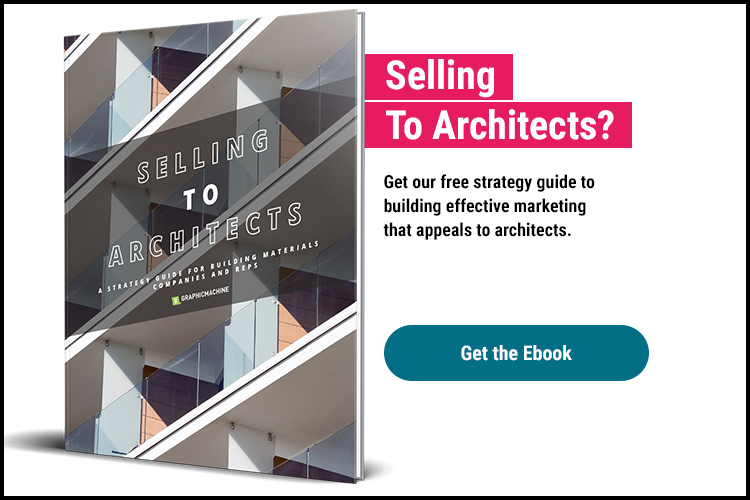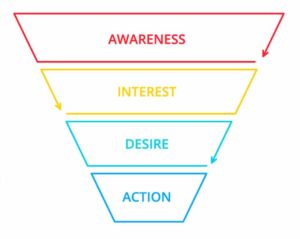Having a robust sales funnel helps building materials company owners sleep at night, because it means there are a good number of leads at various stages of buying readiness. When your sales funnel isn’t so robust, the opposite is true – building products company leadership and sales teams can start to worry about where the next sale is going to come from.
The best way to stave off sales funnel panic is to diagnose and remedy any issues before they become big problems. In this blog post, we’ll show you how to know if you’ve got sales funnel problems.
The Sales Funnel
First, a quick recap of the sales funnel.
At the top of the sales funnel is Awareness. The goal of the Awareness stage is – not surprisingly – to create awareness of your company and what it sells.
Next, we have the Interest stage, in which people become interested in what you offer. Your website is the most important part of the Interest funnel because it’s the first place a prospect will go for more information. The website needs to clearly explain your company and your products – using not only words but also photos and videos.
The third stage is Desire, where the goal is to have the prospect want what you offer. For example, the customer doesn’t just want a window – they want your window.
At the bottom of the sales funnel is the last stage: Action. This is when people do one of two things. They either move forward with a sale or they “drop out” of the funnel and you can begin to re-engage with them in a different stage.
Just like a physical funnel, the top is the widest part. This is because the largest number of people will be in the Awareness stage. As they learn more about your company and your products, some people will decide they don’t currently need or want what you sell, and they will drop out of the funnel. This is a good thing, because people at the bottom of the funnel are people who are likely to buy what you sell. These are the people your sales team should be spending time on.
Being Able to See Your Sales Funnel
It is absolutely vital that you’re able to see your sales funnel. If your company has a customer relationship management tool (CRM) – and you absolutely should – there will most likely be a graphic in your dashboard that displays your sales funnel and how many of your contacts are in each stage. More involved and costly CRMs will move people between sales stages based on triggers that are set up in the back end and dovetail with your marketing platforms, including website, e-newsletter system, and social media accounts. At the other end of the spectrum are less-complicated systems that require you to move people from one stage to another based on criteria you establish. Either way, you will see a funnel-shaped graphic with numbers that represent either the number of prospects in each stage or the dollar value of the prospects in each stage.
In order to get an accurate picture of your sales funnel, you’ll need to continually add information about new sales inquiries and communications with your prospects. This is the only way to get the right data so you can see what’s working. Again, much of this can be automated with paid systems, but even the most expensive and automated systems will still need maintenance.
Common Sales Funnel Problems and How to Fix Them
You don’t have enough leads in your Awareness stage.
Why it matters: The nature of the sales funnel is that not everyone who comes in at the top. The number of people who will actually buy from you is a fraction of the number who are aware of you. For example, assume that 10% of people in the Awareness stage will make their way through the funnel to a sale. If you have 10 Awareness leads, you can reasonably expect to make one sale if everything goes right. However, if you have 200 Awareness leads, the sales number is likely closer to 20. It’s true that leads can come in at any stage of the funnel, but statistically, you will have more success if you have a larger number of leads at the top of your funnel.
How to fix it: Awareness is probably the easiest stage to fill, but it takes some work.
- Make sure your website is optimized for search engines so people who don’t know about you already can find you when they’re looking for what you sell.
- Identify the social media platforms where your customers are and have a presence. Post about what your company is up to, what you’re working on, and recent successes. There’s a fine line between engaging content and non-stop self-promotion, and it’s important to be on the “engaging” side of it.
- Consider a display ad campaign. Display ads are image or video ads for your company that appear on other websites. They’re designed to be passively consumed, so they’re great for planting the seeds of awareness.
People aren’t moving down the funnel.
Why it matters: Having lots of prospects aware of you is part of the equation – but if those people never make it out of the Awareness stage, they’ll never make it to a sale. People need to take an action that moves them down the sales funnel (like signing up for an e-newsletter). They won’t take action without a reason for acting.
How to fix it:
- Put yourself in your prospect’s shoes. What do they want to see, hear, or know in order to want to find out more about you? Create a list of items and use it to develop touchpoints that incentivize your prospects to take action. These could include things like gated content that requires an email address to download, a lunch and learn, or an invitation to a virtual product walkthrough.
- Review your existing marketing materials to make sure they sound appealing to a prospect. There should be some sense of urgency, but avoid veering into “buy this now or your project is doomed” territory.
- Use calls to action (CTAs) strategically throughout your website and your social media. Be specific (“Discover how our system can reduce building maintenance costs by 40%”) and think about what your prospect would find persuasive.
- Make sure you have a plan for moving leads through the funnel. When they sign up for your e-newsletter, what happens next? Define how you’ll track their engagement and steward them from one stage to the next.
People are moving down the funnel, but they’re not buying.
Why it matters: If people aren’t buying from you … you’re not growing your sales.
How to fix it:
- Determine if it’s a marketing problem, a sales problem, or both. If you have all the wrong people in your funnel but they’ve managed to stay engaged enough to get to the bottom, that’s a marketing problem. It means you’re telling the right things to the wrong people. If you have the right people but they’re not buying, that’s a sales problem. It could be that the sales team needs support, or that something about your pricing or your terms is difficult for your prospects to agree to. It could also be some of both.
- If it’s a marketing problem, stop all of your marketing initiatives immediately so you don’t invest more in attracting the wrong people. Put your sales team and your marketing team in a room together so everyone understands exactly the kind of prospect you need and what their pain points are. Refine all of your marketing based on this information.
Everyone’s moving down the funnel. It’s a rectangle instead of an inverted triangle.
Why it matters: If you have a rectangle, you will have the same number of prospects who say they’re ready to buy as you do leads. This may sound like a good result, but it actually means two things: (1) you have few or no long-term prospects, and/or (2) people don’t fully understand what you’re selling (the more niche of a product you offer, the more likely this is to be a problem). If everyone who knows about you is ready to buy today, you can either ramp up capacity to sell to a large number of customers and hope that others come along in the future, or you can turn away people and tell them to try again later. A much better outcome is to use the sales funnel to your advantage to make sure you have people who fully understand your product and who are in different stages of buying readiness.
How to fix it:
- A rectangular sales funnel is an inverted triangle with stages removed. Re-introduce the stages, creating a plan for each. There may be people who move more quickly through the funnel, or people who have already done research elsewhere and are ready to buy the first time they talk with you. For the majority of your prospects, though, you’re going to want to have them go through every stage so that by the time they get to the bottom, they’re likely to be a sale and a good customer.
- Only after you have a process in place, assess your Awareness stage and make sure you have enough leads in that stage. If you focus on bringing in more leads before you fix the underlying structure, you’ll only be making a larger rectangle.
Building up the right sales funnel for your company takes time, consideration, and combined effort from both marketing and sales. By discovering where your funnel might be coming up short, you can fix problems before they become revenue emergencies.

